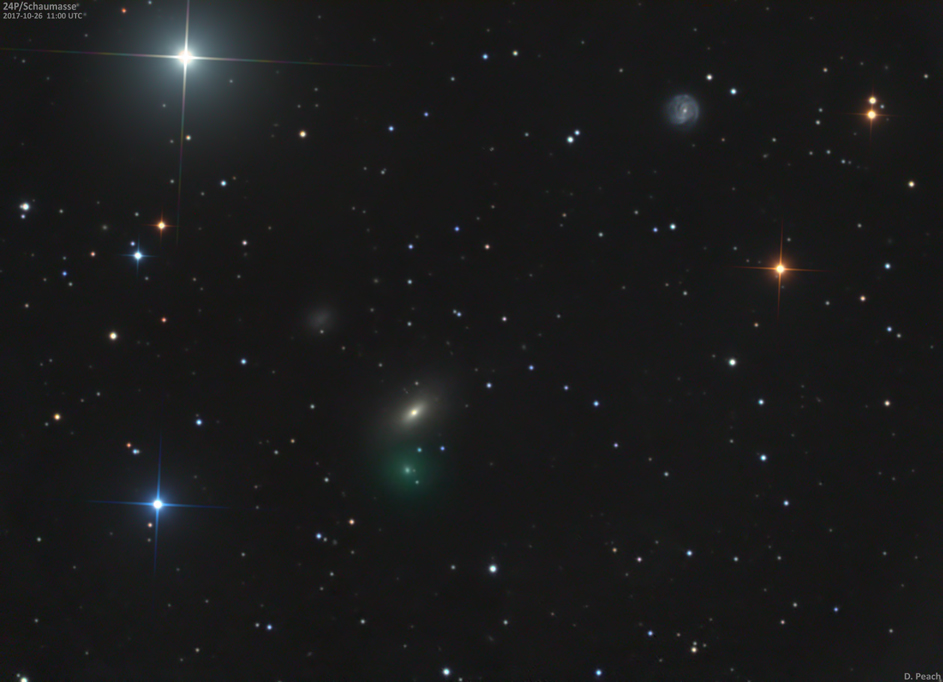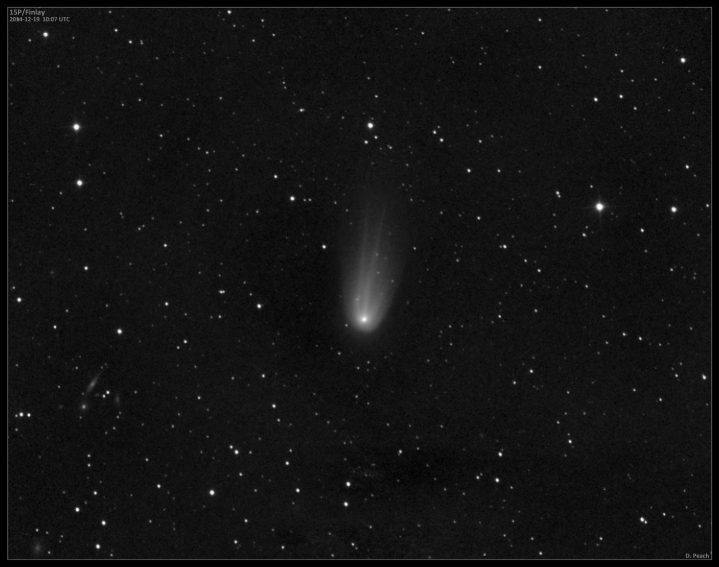

Miscellaneous Comets
In this section you'll find images of other comets. Some faint and some brighter but all having their own unique appearance. Dates/Times on the images.
144P Kushida February 7th, 2024
C/2022 E2 (ATLAS) February 5th, 2024
Comet C/2017 K2 (PanSTARRS) passing The Horsehead Nebula December 31st, 2023
Comet C/2020 V2 (ZTF) passing The Grus Triplet December 12th, 2023
4P/Faye January 9th, 2022
C/2019 L3 (ATLAS) January 7th, 2022
Asteroid 6478 (Gault) January 9th, 2019
60P/Tsuchinshan January 6th, 2019.
Five years of comets (2012 - 2017.)

24P/Schaumasse 20"CDK with FLI camera. LRGB image.
C/2015 V1 (PanSTARRS) 20"CDK with FLI camera. LRGB image.
65P/Gunn 20"CDK with FLI camera. LRGB image.
88P/Howell 20"CDK with FLI camera. LRGB image.
22P/Kopff 20"CDK with FLI camera. LRGB image.
C/2014 A4 (SONEAR) 27" and 20" CDKs. FLI CCD cameras.
C/2015 F4 (Jacques) 24" F6.8 CDK. FLI CCD camera.

Comet 15P/Finlay 20" F4.5 CDK. FLI CCD camera.
Comet C/2014 N3 (NEOWISE) 20" F4.5 CDK. FLI CCD camera.
32P/Comas Sola 20" F4.5 CDK. FLI CCD camera.
Comet C/2013 UQ4 (Catalina) 17" F4.5 CDK. FLI CCD camera.
Comet C/2006 S3 (LONEOS) 20" F4.5 CDK. FLI CCD camera.
Comet 134P/Kowal-Vavrova 17"CDK with FLI-PL603e camera. LRGB: L: 7x3mins. RGB: 1x3mins.
Comet C/2013 V1 (Boattini) 17"CDK with FLI-PL603e camera. LRGB: L: 7x3mins. RGB: 1x3mins.
Comet 290P/Jager 17"CDK with FLI-PL603e camera. LRGB: L: 7x3mins. RGB: 1x3mins.
Comet C/2013 V3 (Nevski) 17"CDK with FLI-PL603e camera. LRGB: L: 4x2mins. RGB: 1x2mins.
Comet P/2013 R3 (Catalina-Pan-STARRS) 17"CDK with FLI-PL603e camera. L: 5x3mins.
Following up on a possible fragmentation of this comet detected by the 10.4m GTC telescope on La Palma.
Comet 154P/Brewington 20"CDK with FLI-PL603e camera. LRGB. L: 5x3mins. RGB: 1x2mins.
20"CDK with FLI-PL4710 camera. L: 10 mins unfiltered.
Comet C/2009 F4 (McNaught) 20"CDK with FLI-PL603e camera. L: 20 mins unfiltered.
Discovered on March 19th, 2009 by Rob McNaught at Siding Spring Observatory. It came to perihelion back at the end of 2011. In the above image despite its great solar distance of 7AU it is displaying an impressive level of activity, including an interesting curved feature within the coma. Also a faint dust tail extends for around 8 arc mins in length.
Comet P/2013 CU129 (Pan-STARRS) 20"CDK@F4.5. FLI-PL6303E camera. L: 7x2mins unfiltered.
Discovered on February 13th, 2013 by the Pan-STARRS 1 telescope on Haleakala. It passed perihelion in early August and at the time of writing remains a nice object for CCD equipped telescopes. Within a week or so of this image the comet had faded out as it recedes from the Sun.
Comet 26P/Grigg-Skjellerup 20"CDK@F4.5. FLI-PL6303E camera. 4x3mins unfiltered. July 29th, 2013.
Discovered in 1902 by John Grigg of New Zealand, and rediscovered in its next appearance in 1922 by John Francis Skjellerup. It has an orbital period of just over 5 years and was visited by the Giotto probe in 1992. Seen above it appears near two interesting galaxies.
Comet 184/P Lovas 2 17"CDK@F4.5. FLI-PL6303E camera. 4x3mins unfiltered. May 13th, 2013.
Discovered in 1986 this periodic comet has an orbital period of 6.8yrs. It is barely detected in the above images glowing dimly at ~20th mag.
Comet C/2010 S1 (LINEAR) 17"CDK@F4.5. FLI-PL6303E camera. 4x3mins unfiltered. May 13th, 2013.
Discovered in September 2010 by the LINEAR survey. This comet shows a small faint dust tail among a rich star field.
Comet 117/P Helin-Roman-Alu 17"CDK@F4.5. FLI-PL6303E camera. 4x3mins unfiltered. May 13th, 2013.
Discovered in October 1989 this periodic comet has an orbital period of just over 8 years. It next comes to perihelion in March 2014. In the above image it displays a faint tail and condensed coma region.
Comet P/2012 B1 (Pan-STARRS) 17"CDK@F4.5. FLI-PL6303E camera. 8x2mins unfiltered. April 4th, 2013.
Comet P/2012 B1 Pan-STARRS. This comet is currently located in Virgo at 15th magnitude. It shows a faint dust tail and a short anti-tail ahead of the nucleus. This appears when the Earth passes through the plane of the cometís orbit, so you see lots of edge-on dust as a sunward pointing tail.
Comet C/2013 E2 (Iwamoto) 20" F4.5 Planewave CDK. FLI CCD camera. 4 x 2mins. March 24th, 2013.
Discovered on March 11th, 2013 by Masayuki Iwamoto of Japan, this comet at the time of writing is located in Aquarius and fairly bright at 12th magnitude. In the above image a very faint dust tail can be seen .
Comet C/2012 T5 (Bressi) 20" F4.5 Planewave CDK. FLI CCD camera. 4 x 2mins. March 12th and 16th, 2013.
Discovered on October 14th, 2012 using the 90cm Spacewatch telescope at Kitt Peak. The comet underwent an outburst in January and brightend to 9th magnitude however it rapidly faded after passing Perhelion on Feb 24th and by the time of the image on March 16th (above) it had faded to become extremely faint (18th magnitude or fainter) while passing globular cluster M15 in Pegasus.
Comet C/2011 F1 (LINEAR) 20" F4.5 Planewave CDK. FLI CCD camera. 4 x 2mins. March 17th, 24th and 31st, 2013.
Discovered on March 17th, 2011 by the LINEAR survey. At the time of this image taken during morning twilight the comet was located in Grus shining at around 12th magnitude. A faint diffuse dust tail can be seen projecting away from the comet nucleus to the right.
Comet C/2011 J2 (LINEAR) 20" F4.5 Planewave CDK. FLI CCD camera. 4 x 60secs. March 2013.
Discovered by the LINEAR survey on May 4th, 2011. At the time of this image the comet was located in Ursa Major glowing at around magnitude 13 and displaying a short dust tail.
Comet 246P/ NEAT 20" F4.5 Planewave CDK. FLI CCD camera. 4 x 2mins. March 2013 (left) and May 2013 (right.)
Discovered in 2004 by the NASA Near-Earth Asteroid Tracking (NEAT) program. It has an orbital period of just over 8 years. In the above image is it seen amongst the stars of Sagittarius at around 14th magnitude showing a short dust tail.
Comet C/2012 L2 (LINEAR) 17" F4.5 Planewave CDK. FLI CCD camera. 6 x 2mins. March 2nd, and April 1st, 2013.
Discovered on June 1st, 2012 by the Lincoln Near Earth Asteroid Research (LINEAR) Survey. At the time of these images the comet was around 12th magnitude.
Comet 125P/ Spacewatch 20" F4.5 Planewave CDK. FLI CCD camera. 5 x 60secs. Feb 2013.
Discovered in 1991 by Tom Gerhels using the 90cm Spacewatch telescope in Arizona, USA. It has an orbital period of around 5.6years and in the above image was fairly close to perhelion - though still only appearing as a dim 17th magnitude glow.
Comet 63P/ Wild 1 17" F4.5 Planewave CDK. FLI CCD camera. 5 x 60secs. Feb 2013.
Discovered by Paul Wild in March 1960 this periodic comet has an orbital period of around 13years. At the time of writing it is currently visible in modest size telescopes at around 13th magnitude.
Comet 273P/ Pons-Gambart 17" F4.5 Planewave CDK. FLI CCD camera. 5 x 60secs. Feb 2013.
Discovered in Nov 2012 by Robert Matson. It has an orbital period of around 188yrs and at the time of writing is visible in modest amatuer telescopes being of around 13th magnitude. It was once thought this comet was possibly linked to D/1827 M1 (Pons-Gambart) but the orbital period is much longer.
C/2012 K5 (LINEAR) 20" F4.5 Planewave CDK. FLI CCD camera. 5 x 60secs. Dec 2012 and Feb and March 2013.
Discovered on May 28th, 2012 by the LINEAR survey this comet reached perihelion during January 2013 at around magnitude 8 to 9 making it a nice object for small telescopes. The images above show it in December 2012 not far from maximum brightness and again in February 2013 having faded to 13th magnitude as it heads away from us.
Comet 17P/Holmes. 80mm apo with Nikon D40 DSLR. 20 x 60secs. December 2007.
This periodic comet returns to the solar system approximately every 7 years and was discovered in 1892. Usually a faint and unremarkable object during its return to the solar system in late 2007 it underwent an outburst of activity causing it to brighten from 17th to 3rd magnitude within just a couple of days making it easily visible to the naked eye. The Coma expanded in size to such a degree it became larger in diameter than the Sun. The above shot taken in mid-December 2007 shows the impressive sight and with its huge misty Coma surrounding a point like nucleus.
C/2004 Q2 (Macholz). 235mm SCT with Fuji S2 pro DSLR. 5 x 60secs. January 2005.
Discovered on August 27th, 2004 this comet reached naked eye visibility by the end of the year. It reached perihelion in January 2005. Its thought to have an orbital period of over 12,000 years.
Copyright © 2003-2013. www.damianpeach.com. No material used within this website may be used, amended or distributed without the consent of the webmaster.